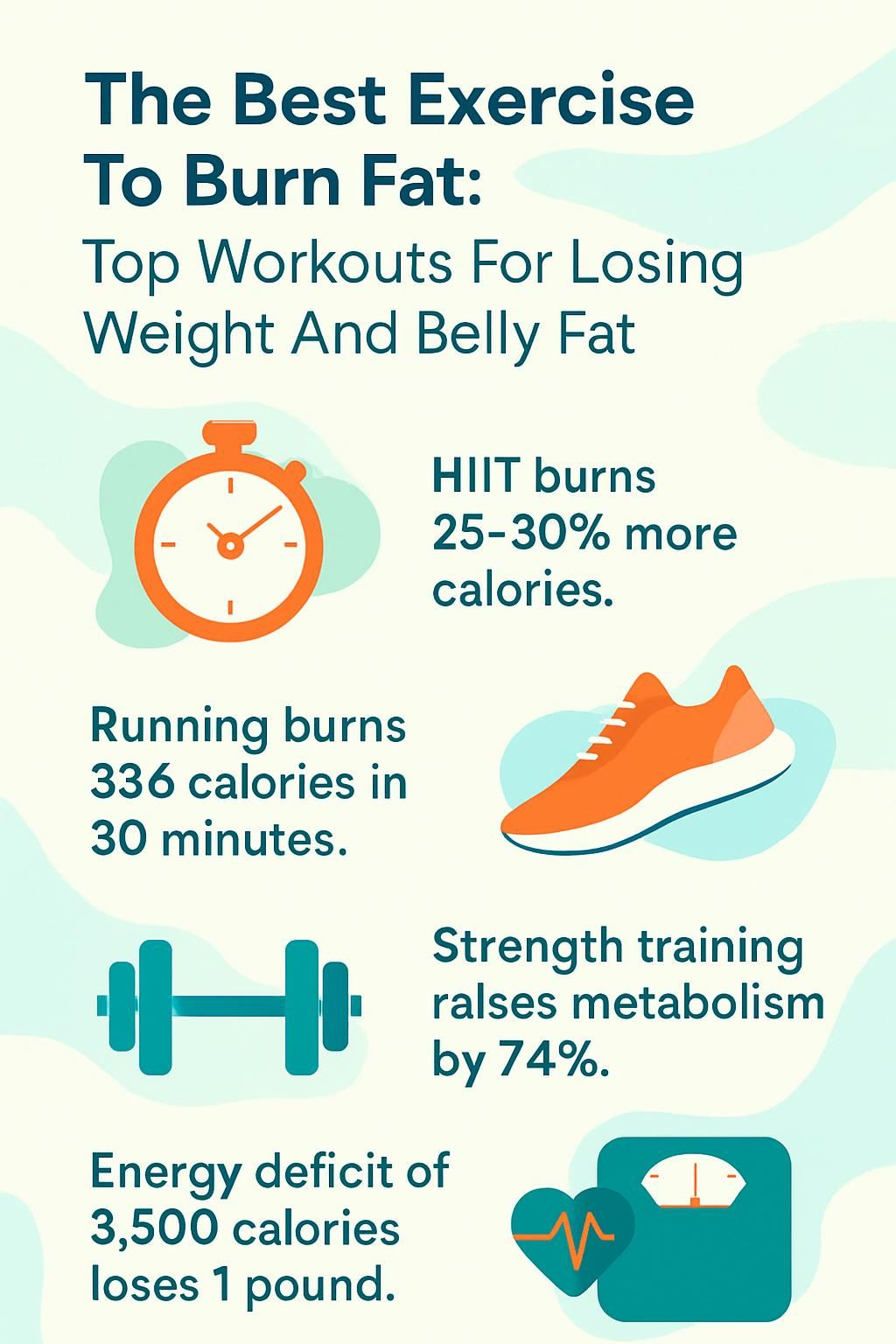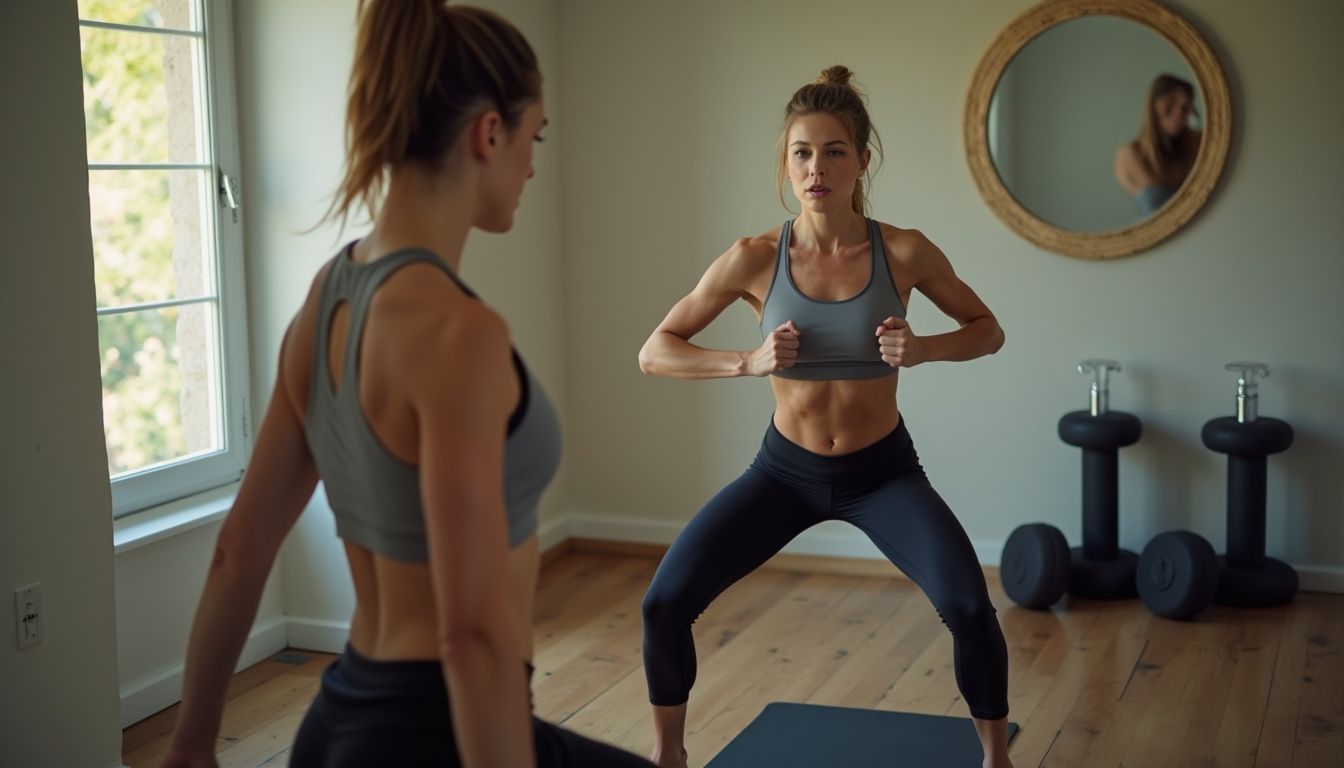The Best Exercise To Burn Fat: Top Workouts For Losing Weight And Belly Fat
Our Nutrition Assistant AI Suite will transform your body. You will lose fat, get toned, and build muscle. Gain confidence and optimal health.
Struggling with belly fat or trying to find the best exercises that actually burn calories? Research shows high-intensity interval training, called HIIT, can burn more calories per minute and keep your body using energy for hours after you stop. This guide gives clear steps on cardio, strength training, and gentle options so you can boost fat loss, protect your joints, and build a plan you can follow.
You will find easy ways to start and smarter ways to progress. Use the ideas that fit your schedule, and adjust the rest to match your fitness level.
Key Takeaways
- High-intensity interval training (HIIT) burns about 25 to 30 percent more calories per minute than steady cardio and can elevate fat burn for up to a day post workout.
- Cardio like brisk walking, running, cycling, swimming, and jump rope helps reduce belly fat. For example, a 185 pound person may burn about 336 calories in 30 minutes of running (Harvard Health).
- Strength training with compound lifts such as deadlifts and kettlebell swings can raise resting metabolic rate by about 7.4 percent, so you burn more calories at rest (Westcott WL., Curr Sports Med Rep. 2012;11(4):209–216).
- Blending aerobic exercise, strength work, and mobility training like yoga or Pilates helps prevent plateaus and supports steady, long term progress.
- Creating a weekly energy deficit near 3,500 calories can lead to about one pound of fat loss, especially with a balanced diet rich in protein, whole grains, produce, and fluids (CDC; Hall KD et al., Am J Clin Nutr. 2012;95(4):989–94).

What Are the Key Benefits of Exercise for Burning Fat?

Exercise raises your heart rate and total energy use, which is essential for fat loss. Aerobic exercise, like jogging, cycling, or swimming, increases calorie burn and can help trim belly fat.
Strength training builds muscle. More muscle raises your resting metabolic rate, or RMR, which is the energy you burn even while sitting. Studies show that both cardio and weights help lower body mass index and support healthy weight.
Regular movement reduces the risk of type 2 diabetes, heart disease, and some cancers. It can also lift your mood and build stronger bones, so you feel better while you work toward fat loss.
“Physical activity burns calories and supports long-term weight management,” says the American Council on Exercise. Pairing brisk walks with yoga helped me lower stress, which made it easier to lose fat around my waist.
Effective Cardiovascular Workouts for Fat Loss
Cardio workouts raise your heart rate and help you burn a lot of calories in a short time. These fat burning exercises can improve body composition and reduce fat around your belly.
How Can Walking Help Reduce Fat?
Walking is simple, joint friendly, and effective. Thirty minutes of brisk walking can add roughly 150 extra calories to your daily burn. A 140 pound person may burn about 7.6 calories per minute, while a 180 pound person may burn about 9.7.
In a 12 week study, sedentary women who walked consistently lost about 1.5 percent body fat and trimmed roughly 1.1 inches from the waist. No special equipment is required, which makes walking a great entry point.
Aim for 30 minutes, three to four days a week. Gradually increase pace or distance. This steady approach helps reduce adipose tissue, the fat stored under the skin, without stressing your joints.
Why Is Running or Jogging Good for Burning Calories?
Running and jogging recruit many large muscles at once, so the calorie burn is high. A 140 pound person can burn about 10.8 calories per minute at 4 to 6 miles per hour. At the same pace, a 180 pound person can burn around 13.9 calories per minute.
At faster speeds, the burn climbs. Harvard Health estimates a 185 pound person may use about 336 calories in 30 minutes of running. Short sessions, three to four times per week, can reduce visceral fat, the deep fat around your organs that raises disease risk.
I noticed less belly fat and better energy after a few weeks of steady jogging. If you have knee concerns, try softer surfaces like a track or grass.
How Does Cycling Help You Lose Weight?
Cycling is a top pick if you want high calorie burn with less joint impact. Depending on effort and body weight, you might burn 400 to 750 calories per hour on a road bike or stationary bike.
At around 10 miles per hour, a 140 pound rider can burn roughly 6.4 calories each minute. A 180 pound rider may burn about 8.2 per minute. Cycling can also improve insulin sensitivity and heart health.
People who prefer less impact often choose cycling over running. It is effective for sedentary beginners and for those returning from injury.
What Are the Fat-Burning Benefits of Swimming?
Swimming trains the whole body at once, which boosts calorie burn and supports rapid fat loss. A 140 pound person may burn about 9 calories per minute at a moderate pace. A 180 pound person may reach about 11.6 per minute.
Different strokes, like front crawl, backstroke, or butterfly, all raise energy use. In a 12 week program, middle aged women who swam for 60 minutes three times a week lost fat and improved flexibility. Swimming can also improve cholesterol and triglycerides, both linked to heart health.
The water reduces joint stress, so you can work hard with less pain. After a knee injury, I used swimming to keep losing weight while staying comfortable.
How Quickly Can Jump Rope Burn Fat?
Jump rope can torch calories in very little time. Ten minutes may burn about 130 to 160 calories, depending on body weight and speed. Intervals work well. Try 30 seconds fast, then 30 seconds easy, and repeat.
This exercise works your legs, arms, and core in every round, and it improves coordination. A rope is cheap, portable, and fits into busy days. Use it as a quick cardio workout or add it to your warm up.
High-Intensity Workouts for Optimal Calorie Burning
High intensity sessions can feel short, but they deliver a powerful training effect. Your body continues to burn calories for hours as it recovers.
What Is High-Intensity Interval Training (HIIT) and How Does It Burn Fat?
HIIT means short bursts of hard effort followed by easy movement. For instance, sprint for 30 seconds, then walk or jog for 60 to 120 seconds. Repeat for 10 to 30 minutes.
Studies show HIIT can burn 25 to 30 percent more calories per minute than steady cycling or treadmill work. Many people also see improved daily energy use after finishing the session.
Adding two HIIT days each week helped me burn more calories through the day. If you want a fast way to lose fat, especially belly fat, HIIT can be a smart tool.
How Do Burpees Help with Rapid Calorie Loss?
Burpees combine a squat, a plank or push up, and a jump. This full body move drives your heart rate high and engages major muscle groups. You may burn about 1.5 calories per rep, which can add up quickly in a 10 minute set.
Burpees can be scaled for beginners or sped up for advanced athletes. Even a short burst in a circuit can lift calorie burn and build endurance.
How Can Mountain Climbers Strengthen Your Core?
Mountain climbers start in a plank. You drive one knee toward your chest, then switch sides rhythmically. This targets the abs and lower back while the shoulders and arms stabilize your body.
Because they raise heart rate fast, mountain climbers can burn many calories in less time. Trainers use them in HIIT for fat loss and for a stronger, more stable core.
Why Use Battle Ropes for a High-Energy Workout?
Battle ropes challenge your upper body, legs, and core at once. Hard intervals can push heart rate above 85 percent of maximum, which supports conditioning and calorie burn.
You can scale the speed or rope thickness to adjust intensity. Many coaches pair ropes with moves like burpees or mountain climbers for a short, high energy circuit.
Strength Training Techniques for Reducing Body Fat
Strength training builds muscle, and more muscle raises your resting metabolic rate. That means you burn calories even when you sit at your desk.
How Does Swinging Kettlebells Boost Metabolism?
Kettlebell swings train the hips, glutes, hamstrings, core, and grip. The explosive motion elevates heart rate, so you build strength and burn calories at the same time.
Working up to 300 swings in a few sets can raise energy use during and after the workout. Multi joint exercises like this often keep your metabolism higher for hours as your body recovers.
Why Are Deadlifts Effective for Increasing Strength?
Deadlifts train the back, hips, legs, and core in one lift. As you gain muscle, your resting metabolic rate increases. In research, just 11 minutes of strength work three times a week for six months raised RMR by about 7.4 percent.
One study found men increased RMR by 9 percent after 24 weeks, while women improved by 4 percent. That can mean roughly 125 extra calories burned per day without extra activity.
Deadlifts also help performance in daily life. Over time, you can lift more weight safely and continue to chip away at body fat.
What Are the Benefits of Squat Jumps for Power?
Squat jumps are a plyometric move that trains power in your quads, glutes, and calves. Each jump spikes heart rate, which boosts calorie burn in a short window.
You do not need special gear, and you can fit them into small spaces. Adding them to a routine can build explosiveness and raise total energy use during workouts.
How Do Push-Ups Help Build Muscle and Burn Fat?
Push ups train the chest, shoulders, triceps, and core using your body weight. Building upper body muscle helps raise RMR, which supports fat loss between workouts.
High rep sets keep your heart rate up and increase calorie burn. After a few weeks of regular push ups, I noticed stronger arms and a flatter stomach.
Beginner-Friendly Low-Impact Exercises
Low impact training protects your joints while still helping you lose fat. Use these options to get fit without extra soreness.
How Can Yoga Improve Flexibility and Aid Fat Loss?
Yoga blends movement, breath, and focus. In a 12 week study with women who had obesity, two 90 minute sessions each week reduced waist size by about 1.5 inches.
Poses stretch and strengthen your muscles, which supports posture and flexibility. Mindful practice may also improve food choices and lower stress, both linked with better long term fat loss.
Why Is Pilates Good for Core Strengthening?
Pilates focuses on the abdomen, lower back, and hips. You control each motion and keep a neutral spine. In an eight week study, women reduced waist, stomach, and hip measures after three 90 minute sessions per week.
Expect to burn about 108 to 168 calories per 30 minutes, depending on level. Consistent practice builds strength, balance, and endurance, which makes daily tasks easier.
How Do Brisk Walks Contribute to Easy Fitness?
Brisk walking is a simple way to build fitness and burn fat. Aim for 30 minutes, three to four times a week, and increase pace or distance over time.
It supports weight control and heart health with little joint stress. Many people also feel a lift in mood and energy after regular walks. This is a practical first step if you want results without a gym.
What Are the Benefits of Climbing Stairs for Endurance?
Stair climbing strengthens your legs and elevates heart rate fast. Climbing just two flights daily could help you lose several pounds over a year.
It can raise good cholesterol, called HDL, and improve joint health. I started using stairs during lunch, and the afternoon energy boost was clear.
Fun Outdoor Activities That Burn Fat
Fresh air adds a spark to your routine, which makes it easier to stay consistent.
How Does Hiking Promote Health and Fat Loss?
Hiking challenges the legs and core on hills and uneven trails. At a moderate pace, someone around 160 pounds may burn about 430 to 480 calories per hour.
Time in nature can reduce stress hormones linked with belly fat. My weekend hikes left me calmer and built leg strength I could feel on stairs.
Why Is Rowing Effective for Cutting Calories?
Rowing uses the legs, core, back, and arms each stroke. That full body effort drives a high calorie burn.
You can row on water or on an indoor rower. A 185 pound person may burn about 399 calories in 30 minutes on a machine like the SkiErg. Add rowing sessions if you want a strong cardio workout that also trains your posterior chain, the muscles on the back of your body.
How Can Playing Sports Like Soccer or Tennis Improve Fitness?
Team and racquet sports use quick bursts of effort, short rests, and constant movement. Soccer may include up to 7 miles of running in a match. Tennis includes sprints, lunges, and serves that keep your heart rate up.
Playing with others builds motivation and consistency. I joined a weekly tennis group, and showing up felt like meeting friends, which made it easy to stick with training.
Strategies to Enhance Fat Burning in Workouts
Simple tweaks can make every session work harder for you.
How Does Mixing Different Exercises Improve Results?
Combining cardio with strength work raises your total calorie burn and keeps you from stalling. Alternate runs with kettlebell swings, or pair cycling with bodyweight circuits.
Variety supports motivation and better adherence, which matters for fat loss. People who rotate activities often stick with training for longer periods.
Why Target Large Muscle Groups for Maximum Fat Burn?
Training large muscles, like quads, glutes, hamstrings, and back, uses more energy than isolating small areas. Moves such as deadlifts, squats, wall balls, and sled pushes drive a higher calorie burn.
High rep sets with short rests lift heart rate and improve conditioning. Once I focused on compound lifts, my fat loss sped up compared to doing only curls or crunches.
How Can Maintaining Correct Form Prevent Injuries?
Good form keeps joints and muscles in safe positions. You move more efficiently and reduce strain. For example, a flat back during deadlifts lowers the chance of pain.
Technique first, then speed or weight. This approach protects you from strains and helps you progress without setbacks.
When Should You Scale Up Intensity for Better Results?
Increase intensity when your routine feels easy and progress slows. If walking pace no longer challenges you, add speed or incline. The American Council on Exercise suggests adding about 5 to 10 percent more weight or time every two weeks.
Gradual progress prevents plateaus and supports steady fat loss. Only increase if you can keep good form for every rep or interval.
What Dietary Choices Support Exercise-Induced Fat Loss?
Food choices can boost performance and speed recovery. A strong nutrition plan helps you train harder and feel better between workouts.
How Do You Balance Calories with Physical Activity?
To lose fat, you need an energy deficit. That means burning more calories than you eat. A common target is about 500 calories per day through fewer calories, more activity, or both, which can lead to around one pound per week.
Tracking meals and workouts in an app helps many people stay consistent. I found that logging made it easier to match intake with my training plan.
Why Is Staying Hydrated Important for Performance?
Water helps control body temperature, moves nutrients to muscles, and speeds recovery. Even mild dehydration can drop performance and focus.
Losing just 2 percent of body weight in fluids can lower your workout output. Keeping a bottle nearby during sessions supports energy and fat burning.
What Foods Are Best for Nutrient Support?
Choose nutrient dense foods. Lean proteins like chicken, fish, tofu, and eggs repair muscles. Whole grains such as oats, brown rice, and whole wheat pasta provide steady energy.
Colorful fruits and vegetables add vitamins and fiber. A small pre workout snack with easy carbs, like a banana or a cereal bar, can improve performance.
Healthy fats from avocados, nuts, and olive oil help you feel satisfied. On training days, build meals around protein, carbs, and healthy fats to recover faster.
How Can You Maintain Consistency in Your Exercise Regimen?
Consistency drives results. Simple habits and clear targets make it easier to stay on track.
How Do You Set Achievable Fitness Goals?
Pick goals that are specific and realistic. Aim to lose about 1 to 2 pounds per week, or roughly 1 percent of body weight. If you walk twice a week now, try three 30 minute walks for the next month.
Use clear numbers and dates, then adjust based on your progress. This approach keeps motivation high and limits burnout.
Why Is Finding Exercises You Enjoy Important?
Enjoyable activities are easier to repeat. Dancing, hiking, or rec league sports can turn workouts into social time.
I struggled with consistency until I joined a local tennis group. The fun and community helped me show up week after week.
How Should You Monitor Your Fitness Progress?
Measure your waist, stomach, and hips every two to four weeks. Photos and a training log also show steady changes even if the scale stalls.
I tracked my waist weekly, and a half inch drop after three weeks kept me going. Data makes it easier to celebrate small wins and adjust your plan.
What Are Ways to Create a Support Network?
Join group classes, team sports, or online communities. Support from friends and family increases consistency and keeps you accountable.
Sharing wins, setbacks, and tips builds confidence. Small group workouts helped me stay focused because people checked in on my progress.
Conclusion
Finding the best exercises to burn calories and reduce belly fat starts with a plan you can follow. Cardio, HIIT, and strength training each support fat loss in different ways. Mix activities like swimming or cycling for joint friendly options. Add compound lifts to build muscle and raise your metabolism.
Nutrition matters too. Create a modest calorie deficit, stay hydrated, and build meals around lean protein, whole grains, and produce. Set clear goals, track progress, and choose activities you enjoy. These steps help you maintain momentum and reach steady fat loss.
References:
- Westcott WL. Resistance Training is Medicine: Effects of Strength Training on Health. Curr Sports Med Rep. 2012;11(4):209–216.
- Hall KD et al. Energy balance and its components: implications for body weight regulation. Am J Clin Nutr. 2012 Apr;95(4):989–94.
Health note: If you have a medical condition, old injury, or take medication, consult a healthcare professional before starting a new exercise program.
FAQs
1. What are the best exercises to burn fat and lose belly weight?
High-intensity interval training, brisk walking, cycling, and swimming help burn calories efficiently. These activities raise your heart rate and increase energy use during and after exercise. Studies show that combining aerobic workouts with strength training leads to greater fat loss than either alone.
2. How often should I work out to see results in losing body fat?
Experts recommend at least 150 minutes of moderate aerobic activity or 75 minutes of vigorous exercise each week for noticeable changes in body composition. Strength training two or more days a week supports muscle growth, which helps boost metabolism.
3. Can certain workouts target belly fat specifically?
No workout can remove only belly fat; however, full-body routines like circuit training reduce overall body mass including abdominal areas when paired with healthy eating habits. Research from Harvard Medical School confirms that consistent physical activity lowers visceral adipose tissue over time.
4. Is there scientific evidence supporting these exercises for weight loss?
Yes, multiple studies confirm that regular cardiovascular exercise combined with resistance movements increases calorie expenditure and reduces both total and central adiposity compared to inactivity or diet alone (Johns et al., 2014). Personal experience shows improved stamina and waist measurements after following a structured routine for several months.
Summary: Aerobic activities such as running or cycling paired with resistance sessions offer effective strategies for burning excess calories and reducing abdominal size according to research findings and practical application alike.







